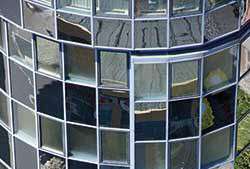Wrapping buildings in a layer of insulating liquid

Large-area fluidic windows use a fluid contained in microchannels to harvest ambient heat and solar energy and manage heat exchange, thereby boosting energy efficiency.
Compared to predecessor technologies, triple glazed windows have greatly improved energy efficiency. The LAWIN (Large-Area Fluidic Windows) project aims to further improve upon that performance, however, by taking a novel approach. LAWIN's researchers are developing windows that provide highly efficient solar energy harvesting and heat exchange through an active building envelope.
'Essentially, we want to enclose a building in a layer of liquid and control the temperature,' says Professor Lothar Wondraczek of the University of Jena's Otto Schott Institute of Materials Research (OSIM) and coordinator of the project.
The core of the technology is structured glass embossed with microfluidic channels through which a functional fluid circulates. The fluid makes it possible to automatically adjust the incidence of light or to harvest exterior heat that is then transported to a heat pump. The current prototype uses aquaeous solutions, but any fluid that has high heat exchange properties and, eventually, adds further functionality such as polychromatism (where the fluid's optical absorption properties depend on the magnitude of incident irradiation, or may be tuned electrically) could be used.
Net zero windows
LAWIN's large-area microfluidic windows and façade elements are based on four types of new materials: low-cost thin and strong cover glasses; microstructured rolled glasses of architectural quality; a glass-glass compound comprising microfluidic channels; and a heat storage liquid designed for transparency and/or active functionality in façade and window implementation. The project consortium aims to reduce embodied energy and CO2 to 0 for window surfaces after four months of usage. LAWIN also aims to improve thermal insulation figures for window surfaces by at least 20 % as well as to reduce the energy spent during the complete life cycle of a building by 10 %.
Bringing it to market
LAWIN hopes to achieve rapid market access and acceptance with its new windows and façade elements.
'The most important thing is the large-scale production process,' says Professor Wondraczek. 'Integrating the technology into the conventional process used to manufacture triple glazed windows is a key objective.'
To really test the technology, LAWIN plans to produce the final prototype on a semi-industrial scale by 2017. But first LAWIN's researchers need to overcome an obstacle.
Embossing one millimetre wide microchannels in glass and then laminating the glass to another, about 1 mm thin sheet of glass requires glass that is extremely flat. Currently, however, glass sheets which are produced by the so-called rolling process are inherently wavy. Consortium members are overcoming this challenge by developing new processing equipment and adapting the production process. The result will be a higher quality very flat piece of glass that could also be used for safety windows or in other high-end applications.
Size matters
'A big challenge is to provide the windows at very low cost in a large size,' says Professor Wondraczek. The current demonstration prototype is 0.25-0.5m2 but the project is targeting a 2m2 final version. The current prototype will be installed in model buildings in northern and southern Europe in 2017 to account for different climatic conditions and actual results will be tested against simulation models. The results from the tests and the simulations will then be used to validate and optimise parameters such as the flow rate of the fluid, the size of channels and the pressure of the fluid inside the channels. These will be incorporated into the 2m2 final version. In addition, the results will be integrated into models used to design buildings.
The consortium estimates that the high-end windows will cost 2.5 times more than state-of-the-art triple glazed windows but that the higher price will be partly offset by energy savings as well as advanced functional or aesthetic features.
LAWIN consortium members believe that the windows could help reduce at least 123 000 tons of CO2 per year generated by heating, and replace at least 2 % of window furnaces in Europe.
'The Large-area fluidic windows will be suitable for virtually any type of building, and builders will be able to replace other windows simply by swapping them out,' says Professor Wondraczek.
Provided by CORDIS


















